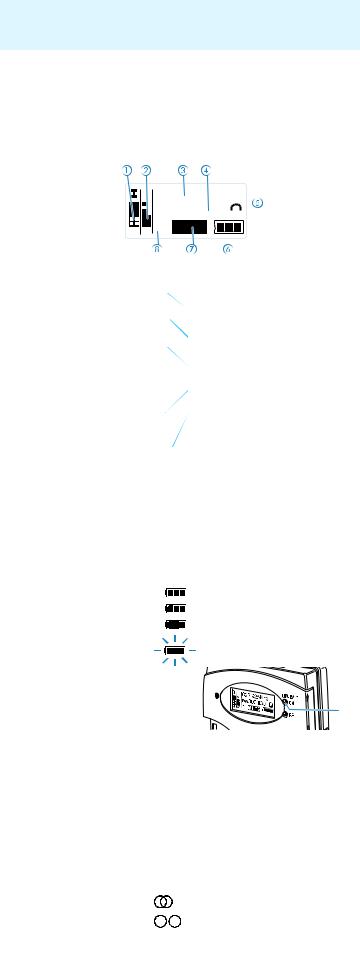Sennheiser EK 300 IEM User Manual

EK 300 IEM
Instruction manual

Contents |
|
Contents |
|
Important safety instructions .......................................................................... |
2 |
The EK 300 IEM G3 diversity receiver .............................................................. |
3 |
Areas of application ........................................................................................ |
3 |
The frequency bank system .......................................................................... |
3 |
Delivery includes .................................................................................................. |
4 |
Product overview ................................................................................................. |
5 |
Overview of the EK 300 IEM G3 diversity receiver .................................... |
5 |
Overview of the displays ................................................................................ |
6 |
Putting the diversity receiver into operation ............................................... |
7 |
Inserting the batteries/accupack ................................................................. |
7 |
Charging the accupack .................................................................................... |
7 |
Connecting the earphones ............................................................................. |
7 |
Attaching the diversity receiver to clothing .............................................. |
8 |
Using the diversity receiver .............................................................................. |
9 |
Switching the diversity receiver on/off and adjusting the volume ...... |
9 |
Deactivating the lock mode temporarily .................................................... |
9 |
Selecting a standard display ...................................................................... |
10 |
Using the operating menu ............................................................................. |
11 |
The buttons .................................................................................................... |
11 |
Overview of the operating menu ............................................................... |
11 |
Working with the operating menu ........................................................... |
12 |
Adjusting settings via the operating menu ............................................... |
14 |
The main menu “Menu” .............................................................................. |
14 |
The extended menu “Advanced Menu” ................................................... |
17 |
Synchronizing an SR 300 IEM G3 transmitter with the |
|
diversity receiver .............................................................................................. |
20 |
Setting the transmitters to intermodulation-free channels |
|
(Easy Setup Sync) ......................................................................................... |
20 |
Synchronizing transmitters with diversity receivers (Sync) ............... |
21 |
Using freely selectable receiving frequencies ......................................... |
21 |
Cleaning the diversity receiver ...................................................................... |
22 |
Recommendations and tips ........................................................................... |
22 |
If a problem occurs ... ....................................................................................... |
23 |
Accessories ......................................................................................................... |
24 |
Specifications .................................................................................................... |
24 |
Manufacturer Declarations ............................................................................. |
25 |
Index .................................................................................................................... |
27 |
For further information, visit the EK 300 IEM G3 product page on our website at www.sennheiser.com.
1

Important safety instructions
Important safety instructions
•Read this instruction manual.
•Keep this instruction manual. Always include this instruction manual when passing the product on to third parties.
•Heed all warnings and follow all instructions in this instruction manual.
•Use only a cloth for cleaning the product.
•Do not place the product near any heat sources such as radiators, stoves, or other devices (including amplifiers) that produce heat.
•Only use attachments/accessories specified by Sennheiser.
•Refer all servicing to qualified service personnel.
Servicing is required if the product has been damaged in any way, liquid has been spilled, objects have fallen inside, the product has been exposed to rain or moisture, does not operate properly or has been dropped.
•WARNING: To reduce the risk of short circuits, do not use the product near water and do not expose it to rain or moisture.
•This product is also intended for professional use. Commercial use is subject to the safety-at-work regulations. Sennheiser, as the manufacturer, is therefore obliged to expressly point out possible health risks arising from use.
This product is capable of |
producing sound pressure exceeding |
85 dB(A). 85 dB(A) is the |
sound pressure corresponding to the |
maximum permissible volume which is by law (in some countries) allowed to affect your hearing for the duration of a working day. It is used as a basis according to the specifications of industrial medicine. Higher volumes or longer durations can damage your hearing. At higher volumes, the duration must be shortened in order to prevent hearing damage. The following are sure signs that you have been subjected to excessive noise for too long a time:
–You can hear ringing or whistling sounds in your ears.
–You have the impression (even for a short time only) that you can no longer hear high notes.
Replacement parts
When replacement parts are required, be sure the service technician uses replacement parts specified by Sennheiser or those having the same characteristics as the original part. Unauthorized substitutions may result in fire, electric shock, or other hazards.
Intended use
Intended use of the EK 300 IEM G3 diversity receiver includes:
•having read these instructions especially the chapter “Important safety instructions”,
•using the product within the operating conditions and limitations described in this instruction manual.
“Improper use” means using the product other than as described in this instruction manual, or under operating conditions which differ from those described herein.
2

The EK 300 IEM G3 diversity receiver
The EK 300 IEM G3 diversity receiver
This diversity receiver is part of the evolution wireless series generation 3 (ew G3). With this series, Sennheiser offers high-quality state-of-the-art RF transmission systems with a high level of operational reliability and ease of use. Transmitters and receivers are designed for monitoring applications and permit wireless transmission with studio-quality sound.
Features of the evolution wireless 300 IEM G3 series:
•Optimized PLL synthesizer and microprocessor technology
•HDX noise reduction system
•Adaptive diversity technology
•Switching bandwidth of 42 MHz
•Scan function (Easy Setup) for scanning the frequency banks for unused channels
•Adjustable and switchable limiter
Adaptive diversity
This diversity receiver uses the ground connection of the earphones cable as its second antenna to provide improved reception.
Areas of application
The receiver can be combined with the SR 300 IEM G3 transmitter.
Diversity receiver |
Earphones |
Transmitter |
|
|
|
|
|
EK 300 IEM G3 |
IE 4 |
SR 300 IEM G3 |
|
|
|
||
|
|
|
PEAK PEAK |
B.Ch: 1. 1 |
ew300IEM |
||
|
|
Stereo Transmitter |
0 |
0 |
|||
|
|
|
-20 |
-20 |
516.000 |
MHz |
|
|
|
|
-10 |
-10 |
|
|
|
|
|
|
-30 |
-30 |
EQ |
|
|
|
|
|
-40 |
-40 |
Standard |
-18dB |
|
|
|
|
AF I |
AF II |
|||
The transmitter is available in the same UHF frequency ranges and is equipped with the same frequency bank system with factory-preset frequencies. An advantage of the factory-preset frequencies is that
•a transmission system is ready for immediate use after switch-on,
•several transmission systems can be operated simultaneously on the preset frequencies without causing intermodulation interference.
The frequency bank system
The diversity receiver is available in 6 UHF frequency ranges with 1,680 receiving frequencies per frequency range:
|
Range A: |
Range G: |
Range B: |
Range C: |
Range D: |
Range E: |
|||
|
516 – 558 |
566 – 608 |
626 – 668 |
734 – 776 |
780 – 822 |
823 – 865 |
|||
|
|
|
|
|
|
|
|
|
|
|
|
|
|
|
|
|
|
|
|
3

Delivery includes
Each frequency range (A–E, G) offers 26 frequency banks with up to 16 channels each:
Channel 1 – frequency preset
Channel 2 – frequency preset
Frequency bank 1 ... 20
Channel 16 – frequency preset
Channel 1 – freely selectable frequency
Channel 2 – freely selectable frequency
Frequency bank U1 ... U6
Channel 16 – freely selectable frequency
Each of the channels in the frequency banks “1” to “20” has been factorypreset to a fixed receiving frequency (frequency preset). The factorypreset frequencies within one frequency bank are intermodulation-free. These frequencies cannot be changed.
For an overview of the frequency presets, please refer to the supplied frequency information sheet. Updated versions of the frequency information sheet can be downloaded from the EK 300 IEM G3 product page on our website at www.sennheiser.com.
The frequency banks “U1” to “U6” allow you to freely select and store receiving frequencies. It might be that these receiving frequencies are not intermodulation-free (see page 20).
Delivery includes
The packaging contains the following items:
1EK 300 G3 IEM diversity receiver
2AA size batteries, 1.5 V
1 pair of IE 4 earphones
1 instruction manual
1 frequency information sheet
4

Product overview
Product overview
Overview of the EK 300 IEM G3 diversity receiver
|
|
|
|
|
|
|
|
|
|
|
|
|
|
|
|
|
|
|
|
|
|
|
|
|
|
|
|
|
|
|
|
|
|
|
|
|
|
|
|
|
|
|
On/off/volume control
3.5 mm stereo jack socket (PHONES), lockable (the ground contact is used by antenna II)
Antenna I
Operation and battery status indicator, red LED lit = ON
flashing = LOW BATT
RF signal indication, green LED lit = RF
Charging contacts
SET button
/ rocker button (UP/DOWN)
Battery compartment
Battery compartment cover
Battery compartment catches
Infra-red interface
ESC button
Display panel, backlit in orange
5

Product overview
Overview of the displays
After switch-on, the diversity receiver displays the “Frequency/Name” standard display. For further illustrations and examples of the different standard displays, refer to page 10.
The display backlighting is automatically reduced after approx. 20 seconds.
823.925MHz


 ew300 IEM
ew300 IEM
RF AF P MUTE 

Display |
Meaning |
|||||||
|
|
|
|
|
|
|
|
|
RF level “RF” |
|
|
|
|
|
Diversity display: |
||
|
|
|
|
|||||
(Radio Frequency) |
|
|
|
|
|
Antenna input I is active |
||
|
|
|
|
|
||||
|
|
|
|
|
|
Antenna input II is active |
||
|
|
|
|
|
|
|||
|
|
|
|
|
|
RF signal level: |
||
|
|
|
|
|
||||
|
|
|
|
|
||||
|
|
|
|
|
||||
|
|
|
|
|
|
Field strength of the received signal |
||
|
|
|
|
|
||||
|
|
|
|
|
||||
|
|
RF |
|
|
Squelch threshold level |
|||
|
|
|
||||||
Audio level “AF” |
|
|
|
|
Peak hold function |
|||
|
|
|
|
|||||
(Audio Frequency) |
|
|
|
|
Modulation of the transmitter |
|||
|
|
|
|
|
(channel-separated when the |
|||
|
|
|
|
|
||||
|
|
|
|
|
transmitter is set to stereo mode) |
|||
|
|
|
|
|
||||
|
|
|
|
|
When the display shows full deflec- |
|||
|
|
AF |
|
tion, the audio input level is exces- |
||||
|
|
|
|
|
sively high. |
|||
|
|
|
|
|
|
|
|
|
Frequency |
Current receiving frequency |
|||||||
|
(see page 17) |
|||||||
|
|
|
|
|
|
|
|
|
Name |
Freely selectable name of the receiver |
|||||||
|
(see page 15) |
|||||||
|
|
|
|
|
|
|
|
|
Lock mode icon |
Lock mode is activated (see page 10) |
|||||||
|
|
|
|
|
|
|
|
|
Battery status |
Charge status: |
|||||||
|
|
|
|
|
|
approx. 100% |
||
|
|
|
|
|
|
approx. 70% |
||
|
|
|
|
|
|
|||
|
|
|
|
|
|
approx. 30% |
||
|
|
|
|
|
|
|||
|
|
|
|
|
|
charge status is critical, the red |
||
|
|
|
|
|
|
LOW BATT LED is flashing: |
||
|
|
|
|
|
|
|||
|
|
|
|
|
|
|
|
|
|
|
|
|
|
|
|
|
|
|
|
|
|
|
|
|
|
|
|
|
|
|
|
|
|
|
|
Muting function |
“Mute” is only displayed on the “Frequency/ |
|||||||
“MUTE” |
Name” standard display (see page 10) |
|||||||
|
• when the transmitter’s RF signal is |
|||||||
|
|
deactivated or |
||||||
|
• when the transmitter is set to mono mode |
|||||||
|
|
and therefore does not transmit a pilot |
||||||
|
|
tone but the receiver’s pilot tone evalua- |
||||||
|
|
tion is activated. |
||||||
or audio channels |
The audio channels are only displayed on the |
|||||||
|
“Frequency/Limiter” and “Frequency/High |
|||||||
|
Boost” standard displays (see page 10) |
|||||||
|
|
|
|
|
Stereo |
|||
|
|
|
|
|
Focus |
|||
|
|
|
|
|
|
|
|
|
Pilot tone “P” |
Activated pilot tone evaluation |
|||||||
|
(see page 18) |
|||||||
|
|
|
|
|
|
|
|
|
6

Putting the diversity receiver into operation
Putting the diversity receiver into operation
Inserting the batteries/accupack
For powering the diversity receiver, you can either use two 1.5 V AA size batteries or the rechargeable Sennheiser BA 2015 accupack (see “Accessories” on page 24).
Open the battery compartment by pushing the two catches in the direction of the arrows and open the cover .
Insert the two batteries or the accupack as shown above. Please observe correct polarity when inserting the batteries/accupack.
Close the battery compartment by pressing on the center of the cover .
The battery compartment cover locks into place with an audible click.
Charging the accupack
To charge the BA 2015 accupack:
Insert the diversity receiver into the L 2015 charger (see “Accessories” on page 24).
The L 2015 charger can only charge the combination BA 2015 accupack/diversity receiver. Standard batteries (primary cells) or individual rechargeable battery cells cannot be charged.
Connecting the earphones
Connect the earphones to the socket .
The ground connection of the earphones cable serves as the antenna for the second diversity section. For details on the connector assignment, refer to the diagram on page 25.
7

Putting the diversity receiver into operation
Attaching the diversity receiver to clothing
You can use the belt clip to attach the diversity receiver to clothing (e.g. belt, waistband).

The belt clip is detachable so that you can also attach the diversity receiver with the antenna pointing downwards. To do so, withdraw the belt clip from its fixing points and attach it the other way round. The belt clip is secured so that it cannot slide out of its fixing points accidentally.
To detach the belt clip:
Lift one side of the belt clip as shown.
Press down the belt clip at one fixing point and pull it out of the receiver housing.
Repeat for the other side.
8
